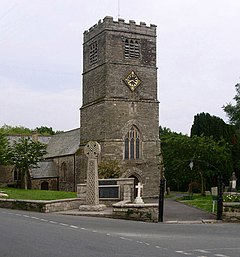Trenython
Tywardreath
|
|
|---|---|
 Tywardreath Church |
|
| Tywardreath shown within Cornwall | |
| OS grid reference | SX084544 |
| Civil parish | |
| Unitary authority | |
| Ceremonial county | |
| Region | |
| Country | England |
| Sovereign state | United Kingdom |
| Post town | PAR |
| Postcode district | PL24 |
| Dialling code | 01726 |
| Police | Devon and Cornwall |
| Fire | Cornwall |
| Ambulance | South Western |
| EU Parliament | South West England |
| UK Parliament | |
Tywardreath (Cornish: Ti War Dreth, meaning "House on the Beach" (or Strand)) is a small hilltop village on the south coast of Cornwall, England, United Kingdom. about 3 miles (5 km) north west of Fowey. It is located in a sheltered spot overlooking a silted up estuary opposite Par and near the beach of Par Sands. It is on the Saints' Way path.
Tywardreath was featured by Daphne du Maurier in her novel The House on the Strand. Although this was a fictional tale of drug-induced time-travel, the history and geography of the area was carefully researched by du Maurier, who lived in a house called Kilmarth (Cornish: Kilmergh, meaning horses' ridge), 1 mile (2 km) to the south.
The seal of the borough of Tywardreath was a Shield of Arms, a saltire between four fleurs-de-lis, with the legend "Tywardreath". The arms are derived from those of the priory: the saltire for St Andrew, the patron of the priory and parish church; the fleur-de-lis for the French mother house at Angers.
Tywardreath was recorded in the Domesday Book (1086) when it was one of 28 manors held by Richard from Robert, Count of Mortain. There were 2 hides of land and land for 12 ploughs. One virgate of land was held by Richard with 4 ploughs and 7 serfs; 8 villeins and 18 smallholders had the rest of the land with 3 ploughs. There were 6 acres of woodland and 100 acres of pasture. The manor was valued at £2 though it had formerly been worth £4.
Although the civil parish is shown under Tywardreath and Par there is an electoral ward (which also includes Par) shown under the name of Tywardreath only. The population of this ward at the 2011 census was 4,897.
The settlement grew out of a Benedictine priory established at around the time of the Norman conquest. Founded from the Abbey of SS. Sergius and Bacchus, Angers in France, it was founded to contain only about seven monks, the endowment being sufficient for that number. The house was poor but powerful in the area, controlling the port of Fowey and having lands scattered over Cornwall. Being regarded as an "alien monastery" subject to a French mother house, the Crown frequently took it into its "protection", taking all its temporal income for itself, as the alien houses' loyalty to the English crown was suspect, and they were sending profits from their English lands to "enemies" abroad. The Crown's action transferred the money from the coffers of a French abbot to those of an English king. The result was a poor, demoralised monastery, devoid of its monks, who were expelled in the early 1400s. A slow revival from about 1406 brought English monks into the house, and it regained its prestige and much of the property it had lost, having become "denizen", i.e. naturalised as English. However, by 1535 and the Valor Ecclesisticus the priory was valued at less than £200 annually, and like many others it was suppressed by the Crown in 1536. Nothing survives of the monastery today, except some carved stones in the parish church, next to where the priory stood. Attempts are being made to explore the site using modern archaeological methods. A modern story (Methuen's 'Little Guide - Cornwall, July 2016) implausibly explains the lack of remains of the priory by saying the last prior shipped the stone back to France.
...
Wikipedia

